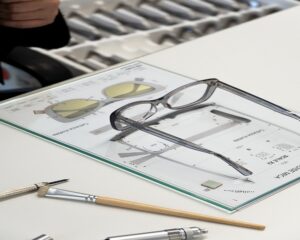In the fast-paced world of eyewear manufacturing, staying ahead of the competition requires careful planning and accurate forecasting. With ever-evolving consumer preferences, eyewear manufacturers must be adept at anticipating market trends and optimizing their production processes. This article will discuss the critical aspects of manufacturing planning and forecasting in the eyewear industry. We will focus on factors such as demand forecasting, production planning, inventory management, and quality control.

Demand Forecasting
Accurate demand forecasting is the cornerstone of effective eyewear manufacturing planning. By anticipating market trends and consumer preferences, manufacturers can align their production processes to meet demand and avoid costly overproduction or stockouts.
Historical data analysis: Examining past sales data can provide valuable insights into seasonal trends, popular styles, and overall market growth. This information can be used to project future demand patterns.
Market research: Keeping a pulse on market trends, can help manufacturers identify new opportunities and plan for upcoming launches.
Collaborative planning: Working closely with sales teams, distributors, and retailers can provide real-time information on market demand and enable manufacturers to make informed production decisions.
Production Planning
Effective production planning ensures that manufacturers can meet customer demand while optimizing resource utilization and minimizing production costs.
Capacity planning: Manufacturers must determine their production capacity based on factors such as workforce size, equipment availability, and factory space. This will enable them to identify any bottlenecks or inefficiencies and make necessary adjustments.
Production scheduling: Creating a detailed production schedule that outlines the sequence of manufacturing operations, lead times, and resource allocation can help manufacturers streamline their processes and ensure timely delivery of finished products.
Contingency planning: Unforeseen events such as equipment breakdowns or supply chain disruptions can impact production timelines. By developing contingency plans and maintaining a flexible production schedule, manufacturers can quickly adapt to unexpected challenges.
Inventory Management
Efficient inventory management is crucial for eyewear manufacturers to maintain a balance between product availability and warehouse costs.
Safety stock: Maintaining a safety stock of raw materials and finished products can help manufacturers avoid stockouts.
Inventory turnover: Regularly monitoring inventory turnover rates can help manufacturers identify slow-moving items and optimize their inventory levels.
Just-in-time (JIT) inventory management: Implementing a JIT inventory management system can minimize inventory holding costs by reducing the amount of stock held on hand and synchronizing production with demand.
Quality Control
A focus on quality control is essential so that the products meet the highest standards of craftsmanship and performance.
In-process inspections: Conducting regular inspections during the production process can help identify and address quality issues.
Final product testing: Rigorous testing of finished products, including stress tests, lens clarity checks, and fit assessments, can ensure that only high-quality eyewear reaches the market.
Continuous improvement: By fostering a culture of continuous improvement, manufacturers can encourage their teams to identify and address inefficiencies, enhance product quality, and streamline production processes.
Planning and forecasting are critical components of a successful eyewear manufacturing operation. By accurately anticipating demand, optimizing production processes and managing inventory, manufacturers can stay ahead of the competition and meet the ever-evolving needs of consumers. With careful planning and a commitment to excellence, eyewear manufacturers can create exceptional products that stand the test of time.









Leave a Reply